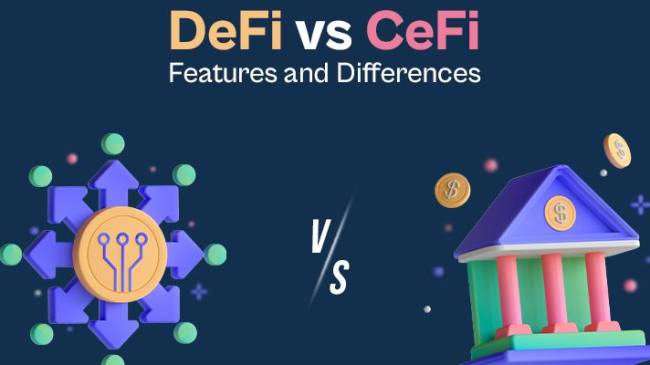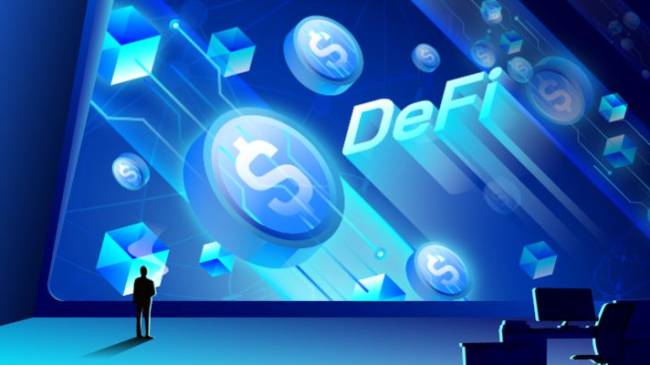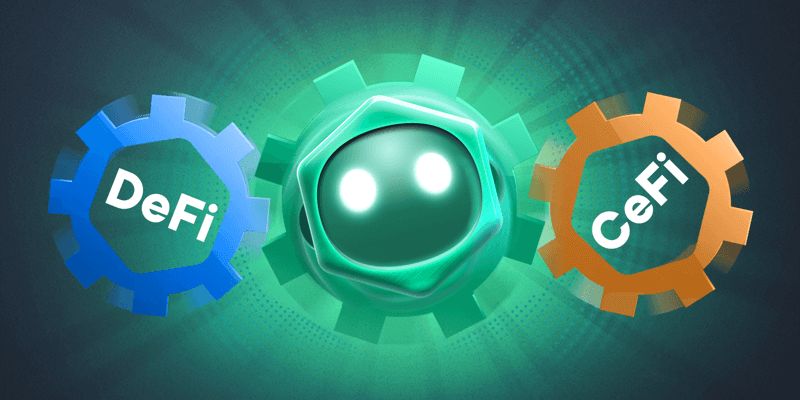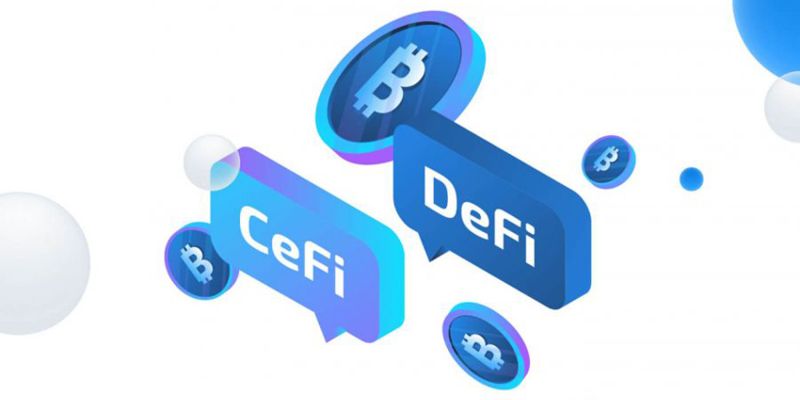Categories: General Information
DeFi vs CeFi - Comparing Decentralized to Centralized Finance
Curious about the differences between DeFi vs CeFi? Check out this informative article for a breakdown of the key distinctions between centralized finance and decentralized finance.
In the world of finance, there are two distinct paradigms that have emerged in recent years: DeFi vs CeFi. In this article, we'll take a closer look at the key differences between CeFi and DeFi, and explore the benefits and drawbacks of each system. Whether you're an investor or just curious about the world of blockchain and finance, understanding the differences between these two paradigms is essential for navigating the rapidly changing landscape of the financial industry.
Table of Contents
What is centralized finance (CeFi)?
What is CeFi?
Centuries ago, in the ancient civilization of Mesopotamia, the concept of centralized finance was introduced, marking the birth of currency. Through the course of history, humans have used a diverse range of goods and assets as currency, including livestock, land, cowrie shells, precious metals, and fiat currencies. While some currencies derive their worth from inherent value, such as land, others are given an imputed value, like fiat currency.
Despite numerous attempts to create a stable, everlasting currency and finance system, the notion of a centralized institution has always been fundamental to their success. This typically involves a government supporting the financial worth of a currency and commanding a military force. However, what does CeFi mean in the context of cryptocurrency?
The central principle behind centralized exchanges (CEXs) in crypto is that all trading orders are routed through a central exchange under the umbrella of centralized finance. Well-known CeFi companies, such as Binance, Coinbase, and Kraken, allow users to create accounts and utilize their platforms primarily to send and receive tokens. In addition to crypto trading, these exchanges offer services such as lending, borrowing, and margin trading.
However, the funds held on these exchanges are not under users' direct control and are subject to risks if the exchange's security protocols fail. As a result, centralized exchanges have been targeted by security attacks. Despite these risks, users are comfortable revealing personal information and entrusting their funds to centralized exchanges, largely due to their reputation for reliability and trustworthiness. Additionally, centralized exchanges employ dedicated customer support staff to assist users, which further enhances their perceived reliability and inspires confidence in customers that their finances are secure.

How does CeFi work?
CeFi, short for Centralized Finance, refers to financial systems and platforms that operate in a centralized manner, typically with a central authority or intermediary overseeing the transactions and activities. CeFi platforms include traditional banks, financial institutions, and centralized cryptocurrency exchanges. Here's an explanation of how CeFi typically works:
User Registration and Identity Verification: To use a CeFi platform, users need to create an account by providing personal information and completing identity verification processes. This helps ensure compliance with regulations and prevent fraudulent activities.
Deposit Funds: Once registered, users can deposit funds into their accounts. This can be done through various methods such as bank transfers, wire transfers, or credit/debit card payments. The funds are held and managed by the central authority of the platform.
Trading and Transactions: With funds deposited, users can engage in various financial activities offered by the CeFi platform. This can include trading traditional financial assets like stocks, bonds, and commodities, as well as cryptocurrencies. The platform facilitates the matching of buyers and sellers and executes the transactions.
Order Execution and Settlement: When a user places an order to buy or sell an asset, the CeFi platform matches the order with a suitable counterparty. The platform typically holds custody of the assets being traded, and the ownership is transferred within the platform's internal ledger. The transaction is settled by updating the account balances accordingly.
Withdrawals and Transfers: Users can withdraw funds or transfer assets from their accounts, subject to the platform's policies and any applicable fees. The platform facilitates these requests and ensures the assets are delivered to the intended recipient or external wallet.
Security and Risk Management: CeFi platforms employ various security measures to protect user accounts and assets. These may include encryption, multi-factor authentication, and cold storage for cryptocurrencies. Additionally, risk management practices, such as anti-money laundering (AML) and know-your-customer (KYC) procedures, are implemented to comply with regulatory requirements.
Customer Support and Services: CeFi platforms typically provide customer support services to address user inquiries, issues, and technical difficulties. They may also offer additional services such as lending, borrowing, margin trading, and investment products.
While CeFi platforms offer convenience and familiar financial services, they rely on a centralized authority and can be subject to censorship, regulatory compliance, and potential single points of failure. It's important for users to be aware of these trade-offs when utilizing CeFi platforms and to consider alternative decentralized finance (DeFi) solutions that provide greater user control and transparency.
Use of CeFi
One of the most promising applications of CeFi lies in its potential to revolutionize cross-border payments. Presently, the process of sending money internationally is marred by sluggishness and exorbitant costs due to the necessity of currency conversion and the fees imposed by banks and other intermediaries. However, CeFi services have the capacity to streamline this cumbersome process by enabling users to conduct payments using cryptocurrencies, which can subsequently be converted into the recipient's local currency. This not only expedites the transaction compared to the traditional banking system but also eliminates the need for currency conversion fees.
Furthermore, CeFi services have the potential to wield a significant influence in the lending sector. At present, the lending market is largely controlled by major financial institutions, thereby posing challenges for borrowers to access favorable terms and rates. Nonetheless, CeFi services provide a more decentralized and competitive lending market, empowering borrowers with a plethora of options and better rates.
Although CeFi services are still in the early stages of development, their evolution remains uncertain. Nonetheless, the potential rewards associated with CeFi are substantial, and it is highly probable that we will witness an increasing number of businesses and individuals embracing these services in the foreseeable future.
Advantages of CeFi
There are multiple advantages associated with the CeFi model, including:
Enhanced customer service: CeFi cryptocurrency exchanges often prioritize customer support and provide dedicated services to assist users.
Fiat conversion: CeFi exchanges offer the convenience of converting traditional fiat currencies into cryptocurrencies, facilitating seamless transactions between the two forms of currency.
Cross-chain support: CeFi platforms incorporate mechanisms that facilitate cross-chain exchanges, allowing users to seamlessly trade and exchange multiple types of cryptocurrencies.
Margin trading: Several CeFi exchanges provide users with the option to engage in margin trading, where they can trade with borrowed funds, thereby amplifying their trading capabilities and potential profits.
Income generation: CeFi introduces the possibility of earning interest income on held assets, providing users with an additional avenue to generate passive income from their cryptocurrency holdings.
In summary, the CeFi model brings forth a range of benefits, including efficient customer service, fiat-to-crypto conversion, cross-chain support, margin trading opportunities, and the potential for earning interest on assets.
Disadvantages of CeFi
There exist several drawbacks associated with CeFi:
Custody: One of the disadvantages of CeFi is that funds are kept outside the control and ownership of users. They are held by third-party entities, introducing a level of reliance and potential vulnerability.
Regulatory Risk: CeFi platforms are exposed to potential risks arising from compliance with regulatory authorities. These risks can include legal and regulatory changes that may impact the platform's operations and the availability of its services.
Accounting: Another drawback of CeFi is the reliance on traditional accounting practices. Instead of being entirely automated through smart contracts, the accounting and reconciliation processes are managed by CeFi entities. This introduces a centralized approach, which can be more time-consuming and less transparent compared to fully decentralized alternatives.
What is decentralized finance (DeFi)?
What is DeFi?
Decentralized finance, commonly known as DeFi, is a relatively new paradigm that aims to transform the traditional financial system by leveraging blockchain technology. At its core, DeFi is a novel approach to organizing and facilitating cryptocurrency-based transactions, exchanges, and financial services without any centralized control or intermediaries.
Unlike centralized finance models that rely on a central authority to manage transactions and custody of assets, DeFi operates on a decentralized system that enables individuals to have more control and autonomy. In the DeFi model, there are no intermediaries or centralized authorities that can manipulate the flow of transactions. Instead, transactions are conducted in a peer-to-peer (P2P) manner, with no centralized authority.
One of the fundamental components of the DeFi model is the custody of assets. In this approach, individual traders have full control over their private cryptographic encryption keys, which enable them to manage their cryptocurrency assets without relying on a third party. Transactions within the DeFi model are facilitated through smart contracts, which are typically supported on Ethereum-based blockchains.
Moreover, the DeFi model encompasses the concept of decentralized exchanges (DEXs) that are designed to connect and enable individuals to execute cryptocurrency transactions without any centralized control. Additionally, DeFi is closely associated with the concept of decentralized applications (dApps) that are predominantly utilized for financial services use cases.
Overall, DeFi's decentralized nature offers several benefits over traditional financial models, such as transparency, autonomy, and increased accessibility to financial services. As the DeFi ecosystem continues to grow and mature, it has the potential to transform the financial industry, enabling greater financial inclusion, and improving the lives of people around the world.

How does DeFi work?
Decentralized Finance (DeFi) relies on the use of blockchain technology, which is often based on Ethereum in many DeFi operations. A blockchain is a type of immutable distributed ledger that uses cryptographic encryption to secure entries that are used for transactions. In addition to being the basis of cryptocurrencies, blockchains also underpin many DeFi operations.
In an Ethereum-based blockchain, DeFi smart contracts play a critical role in enabling the model to work. A smart contract is an application that runs on a blockchain using distributed ledger technology and cryptographic encryption capabilities. These smart contracts specify the terms and conditions for the execution of a given operation, allowing financial transactions to occur programmatically without the need for a central authority.
With DeFi smart contracts, the terms and conditions of a transaction are transparent and available as code, making them viewable by others for auditing and analysis. As a result, there is no need for a central authority to enable a smart contract with DeFi, and the system works on a peer-to-peer (P2P) model. If two peers agree to execute a transaction, it can be done without the need for a third-party central authority.
Moreover, the DeFi model emphasizes empowering the individual user, and cryptocurrency asset custody relies on control of both private and public encryption keys. With the decentralized approach of DeFi, custody in the form of private cryptographic encryption keys is held by the individual, giving them complete control over their assets.
In summary, DeFi relies on blockchain technology, specifically Ethereum-based blockchains, and utilizes smart contracts to execute transactions in a decentralized, P2P model. With DeFi, there is no need for a central authority to enable transactions, and the model empowers the individual user through complete control over their cryptocurrency asset custody.
Uses of DeFi
DeFi, or Decentralized Finance, is built on the premise of peer-to-peer (P2P) financial transactions. This means that two parties can directly exchange cryptocurrency for goods or services without the need for a third party. In the case of DeFi, P2P transactions can also be used to fulfill an individual's loan needs. An algorithm matches peers that agree on the terms of the lender, and the loan is issued. The payments from P2P transactions are made through a decentralized application or dApp, and follow the same process in the blockchain.
DeFi offers several benefits, including accessibility, low fees and high-interest rates, security, transparency, and autonomy. With DeFi, anyone with an internet connection can access the platform, and transactions occur without geographic restrictions. The ability for any two parties to directly negotiate interest rates and lend money via DeFi networks results in low fees and high-interest rates.
The use of smart contracts published on a blockchain and records of completed transactions that are available for anyone to review but don't reveal the user's identity provides security and transparency. Blockchains are immutable, meaning that once a transaction is recorded, it cannot be changed.
DeFi platforms are also autonomous, as they don't rely on any centralized financial institutions and are not subject to adversity or bankruptcy. The decentralized nature of DeFi protocols mitigates much of the risk associated with traditional financial institutions. Overall, DeFi is a promising solution for a more accessible, secure, and transparent financial system.

Benefits of DeFi
Decentralized Finance (DeFi) presents a multitude of advantages that can enhance user confidence, security, and trust in cryptocurrency-based transactions and applications. These benefits include the following:
Decentralization: Unlike centralized finance (CeFi), DeFi is not subject to the inherent risks associated with a single point of failure. In CeFi, the failure of an exchange can result in a complete collapse and loss of user funds and accounts. DeFi's decentralized structure, on the other hand, distributes control and eliminates the risk of a single point of failure.
Permissionless: DeFi's decentralized model does not require a central authority to approve or enable a transaction. The programmatic logic of smart contracts defines what is possible, and users can interact with the system without the need for intermediaries.
Transparency: DeFi's smart contract model allows users to understand the terms and logic of a transaction in a transparent manner, without hidden code or obscured processes. This transparency instills trust in the system and its processes.
Anonymity: While smart contracts can be transparent on the blockchain, users are not required to identify themselves in DeFi transactions. Unlike in centralized and regulated models, Know Your Client requirements do not apply in DeFi.
Custody: In DeFi, users have complete control over their assets, and the custody of the cryptographic private key for cryptocurrency tokens is held by the user. This eliminates the risk of third-party custodians mismanaging funds.
DApps: DeFi supports decentralized applications (dApps), which allow users to benefit from financial services applications and other use cases, such as gaming and social media. DApps can operate independently of traditional financial institutions and provide greater accessibility and inclusivity.
Fees: DeFi provides users with the promise of lower fees than transactions executed in the CeFi model, as there is no central authority to charge fees. This allows users to save money on transactions, making DeFi an attractive option for cost-conscious users.
Challenges of DeFi
Although DeFi has numerous advantages, it also presents several potential difficulties that should not be overlooked, as outlined below:
Firstly, the primary challenge facing DeFi is its perceived complexity. DeFi operates on a peer-to-peer (P2P) basis, using smart contracts and complex algorithms that may be difficult to grasp for those unfamiliar with the technology. This complexity can lead to confusion about how a particular service or application functions.
Secondly, customer service can be problematic with DeFi, as there is no central authority or service to seek assistance. This can make it difficult to resolve any issues or problems that may arise when using DeFi services.
Thirdly, DeFi approaches may be more volatile due to the lack of a central authority to control or limit transaction or market momentum. This can potentially result in more significant price fluctuations and increased risk for users.
Finally, DeFi platforms have become increasingly vulnerable to attacks in recent years, with hackers targeting them for monetary gain. A warning issued by the Federal Bureau of Investigation in August 2022 revealed that over $1 billion in assets had been stolen in just a three-month period. This highlights the importance of maintaining strong security measures to safeguard against such attacks.
The emergence of blockchain technology and its decentralized and permissionless features has led to the development of new types of digital currencies. One of the most powerful features of blockchain is its ability to enable the transfer and trade of financial assets without the need for trusted intermediaries. Decentralized finance (DeFi), a sub-field of blockchain, focuses on creating financial technology and services on top of ledgers with smart contracts to provide services without intermediaries by leveraging cryptocurrencies.
In the current financial system, financial institutions act as guarantors of transactions. However, in DeFi, smart contracts replace financial institutions as guarantors of transactions. DeFi is compatible with most of the products found in centralized finance (CeFi), including asset exchanges, loans, leveraged trading, decentralized governance voting, and stablecoins. As the number of goods available in DeFi continues to increase, more complicated products like options and derivatives are also evolving rapidly.
Transparency, control, and accessibility are three key characteristics of DeFi. DeFi provides transparency by enabling users to examine the precise rules that govern the operation of financial assets and goods, eliminating private agreements, back-deals, and centralization, which are critical barriers to CeFi transparency. DeFi gives users control over their assets by allowing them to remain the custodians of their assets, meaning no one can censor, move, or destroy their assets without their permission. Anyone with a decent computer, internet connection, and basic knowledge can design and deploy DeFi goods. The blockchain and its distributed network of miners handle the actual operation of the DeFi software.
Different between DeFi vs CeFi
Public verifiability
The concept of public verifiability in DeFi refers to the requirement that the execution and bytecode of a DeFi application must be publicly verifiable on a blockchain in order for it to be classified as non-custodial. Although the application code may not always be open-source, the transparent and public nature of blockchain technology ensures that any DeFi user can observe and verify the orderly execution of DeFi state changes. This level of transparency sets DeFi apart from CeFi and gives it an unparalleled ability to establish trust within the financial ecosystem.
Atomicity
Another attribute that distinguishes blockchain transactions is atomicity, which allows for a series of sequential actions, including multiple financial transactions, to be performed in a single transaction. This atomicity feature ensures that the transaction will either complete with all of its activities or fail collectively. In contrast, CeFi lacks this programmable atomicity attribute and instead relies on expensive and slow legal agreements to enforce it. By providing a streamlined and efficient approach to atomicity, blockchain technology further enhances the overall functionality and reliability of DeFi.
Anonymous development and deployment
When it comes to anonymity, decentralized finance (DeFi) has an advantage over centralized finance (CeFi). While CeFi transactions provide less anonymity to users, many DeFi projects are created and run by anonymous teams, with even Bitcoin's founder remaining unidentified. DeFi smart contracts are implicitly managed by miners once they are installed, and some anonymous DeFi applications may not have a front end, which requires users to interact directly with the smart contract.

Custody
In terms of custody, DeFi allows customers to have direct control over their assets without having to wait for the bank to open, unlike CeFi. However, this comes with a great deal of responsibility, and unless insurance is underwritten, users bear most of the technological risks. As a result, centralized exchanges (CEXs), which are similar to traditional custodians, are popular for keeping cryptocurrency assets.
Trading of crypto assets
When it comes to trading crypto assets, CEXs, and DEXs operate differently. CEXs use limit order books, which are off-chain records of outstanding orders placed by traders. In contrast, DEXs match counterparties in a transaction using automated market-maker (AMM) protocols. Prices are determined by mathematical algorithms based on transaction volumes.
Execution order malleability
When using permissionless blockchains, users typically share their intended transactions via a peer-to-peer network. Since there is no centralized entity controlling the transaction execution order, peers can engage in transaction fee bidding contests to influence the order. This malleability of the order has led to the demonstration of numerous market manipulation tactics, which are currently widespread on blockchains.
In contrast, regulatory bodies in centralized finance (CeFi) impose strict rules on financial institutions and services, including the implementation of transaction ordering. However, such regulations are possible due to the centralized nature of CeFi's financial intermediaries.
Transaction costs
Transaction costs play a crucial role in DeFi and other blockchain networks by deterring spam. However, unlike CeFi, where financial institutions can provide transaction services for free, thanks to their ability to rely on Anti-Money Laundering (AML) verifications of their clients, DeFi platforms must charge transaction fees to ensure the integrity of their network.
Non-stop market hours
CeFi markets are known to experience frequent outages, unlike DeFi, where transactions can be processed around the clock. The New York Stock Exchange and the Nasdaq Stock Exchange, the two primary trading venues in the United States, operate from 9:30 am to 4:00 pm Eastern Time, Monday through Friday. On the other hand, DeFi markets are open 24 hours a day, seven days a week, providing continuous trading opportunities for investors. However, unlike CeFi, DeFi lacks pre-and post-market trading, where liquidity on several goods is generally thin during these periods.
Privacy
When it comes to decentralized finance (DeFi), true anonymity is hard to come by on blockchains that utilize non-privacy-preserving smart contracts. Instead, these blockchains only offer a degree of pseudo-anonymity. This lack of anonymity becomes particularly relevant when converting fiat money to cryptocurrency assets. Centralized exchanges with anti-money laundering (AML) policies are often the most convenient option for making these conversions. However, this convenience comes with a cost: these exchanges have the power to reveal the ownership of cryptocurrency addresses to law enforcement authorities.
Arbitrage risks
In order to minimize this risk, arbitrage should ideally be conducted atomically. However, unless arbitrageurs have a special arrangement with exchanges to ensure atomicity, arbitrage on centralized and hybrid exchanges is always exposed to market price volatility.
One way to conduct relatively risk-free arbitrage in the DeFi space is by trading between two decentralized exchanges (DEXs) on the same blockchain. This is possible due to the atomicity characteristic of the blockchain, which allows traders to create a smart contract that performs the arbitrage and automatically reverts the transaction if it doesn't generate a profit. However, arbitrage between two DEXs on separate blockchains carries a similar level of risk as arbitrage on centralized and hybrid exchanges.
Inflation
Inflation is a phenomenon that occurs when the existing currency supply loses value as a result of an influx of new currency. While inflation is generally defined as the erosion of a currency's purchasing power, the correlation between supply and inflation is not always straightforward. Sometimes, an increase in the money supply does not result in inflation.
Central banks in CeFi hold the authority to create fiat money, and inflation is typically measured against a basket of consumer goods known as a consumer price index. Conversely, DeFi operates on a different model, where the supply of various cryptocurrencies can fluctuate. For instance, Bitcoin (BTC) has a finite supply and is likely to face the challenge of sustaining economic activity without a cap on demand. This may result in a scarcity of currency. Furthermore, Bitcoin and other blockchains may be susceptible to security vulnerabilities without a block reward mechanism to incentivize miners.
It is yet to be determined whether cryptocurrencies like BTC will experience severe income inequality as a result of fiat system inflation. Currently, there is no conclusive evidence suggesting that cryptocurrencies solve this issue.
Cross-chain services
The trading of major cryptocurrencies like BTC, which are generated on independent blockchains, is typically done through CeFi services. DeFi services, on the other hand, often do not support these tokens due to the challenges involved in completing atomic cross-chain exchanges.
CeFi services address this issue by storing funds from various blockchains, whereas decentralized services require tokens to follow Ethereum token standards to achieve interoperability. This is a significant advantage for CeFi, as many of the highest-market-cap and most frequently traded coins exist on separate blockchains that do not adhere to interoperability rules.
Fiat conversion flexibility
In terms of converting fiat currency to Bitcoin and vice versa, centralized services typically offer greater flexibility than decentralized services. Because fiat-to-crypto conversion necessitates the involvement of a centralized institution, most DeFi providers do not offer fiat on-ramps. Additionally, CeFi services have the ability to onboard customers more quickly, resulting in an improved customer experience.

Similarities between DeFi vs CeFi
Despite the differences between DeFi vs CeFi approaches for cryptocurrency, there are a number of similarities that are worth noting. Both DeFi vs CeFi relies on blockchain technologies as the foundation for their operations, enabling them to provide a wide range of cryptocurrency-related financial services. The ability to buy, sell, and trade cryptocurrencies is a foundational operation that is common to both DeFi vs CeFi.
DeFi utilizes Ethereum smart contracts, which can also be used in CeFi use cases with some authority attached to assist with setting up, managing, and operating the contract. Although it may be easier for regulators to impose different types of financial compliance on CeFi, profits from CeFi are still likely to be subject to government tax authorities.
There is also a significant amount of security risk associated with both CeFi and DeFi, with DeFi being more frequently targeted by attackers. However, ongoing attacks against CeFi are also a concern. Central authorities in CeFi can and should take additional measures to help secure operations.
While there are important differences between CeFi and DeFi, such as the degree of decentralization and control, they both share the common goal of promoting and enabling the use of cryptocurrency. Overall, blockchain technology serves as the foundation for both approaches, allowing for the creation of innovative financial services and applications that leverage the unique capabilities of cryptocurrency.
Conclusion
While both DeFi vs CeFi have their own unique advantages and disadvantages, it's clear that decentralized finance is a rapidly growing sector that is challenging the status quo of traditional finance. As blockchain technology continues to mature and more users become comfortable with using decentralized financial services, it's likely that DeFi will continue to gain traction and become a more prominent part of the financial landscape. Whether you choose to use CeFi or DeFi, understanding the differences between these two paradigms is crucial for making informed financial decisions in today's world.
Follow Uniultra.xyz for more blockchain information!
